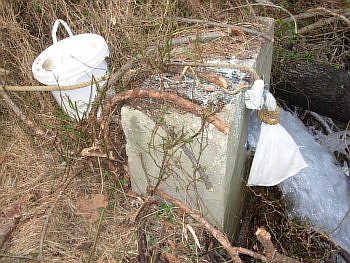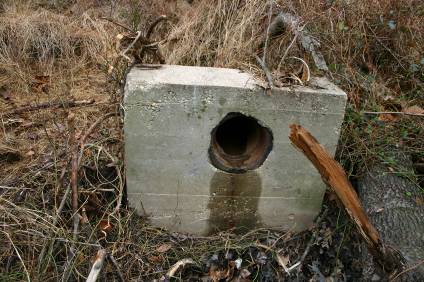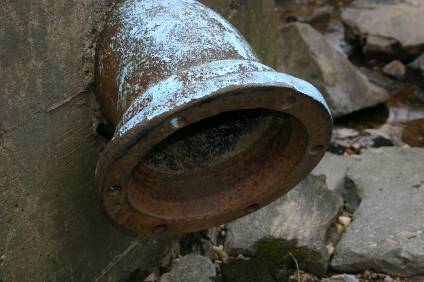


|

|
Chlorinated Water Being Dumped into Sligo
|
|
Ed Murtagh May 24, 2007 |
Original Posting January 10, 2006 |
DEP and MDE Reports January 11, 2006 |
WSSC Explanation January 21, 2006 |
|||
|
FoSC Members Timelines January 22, 2006 |
Letter to WSSC from FoSC January 24, 2006 |
WSSC Response to FoSC Letter February 9, 2006 | ||||
|
In January of 2006, chlorinated water was discharged into Sligo Creek. The discharge was related to work on a new WSSC water main in Wheaton. The problems started when contract work crews attempted to drain a Wheaton water main. There were two major problems:
De-chlorination being jury-rigged at Sligo Headwaters, January 2006

According to Jim Neustadt, Director Communications & Community Relations, following the chlorinated water discharge into Sligo Creek in January 2006, WSSC's Potable Water Discharge Pollution Prevention (P2) Plan was reviewed. According to WSSC, this plan, which did not consider the existence of these non-standard endwall blowoffs in their system, needed to be updated. The revised plan includes the following:
Older non-standard endwall (installed in 1951) without any adaptor

Newer (circ. 1981) endwall that allows hoses or equipment housings to be attached

Endwall Blowoff SurveyAccording to Martin Chandler, WSSC Environmental Group, WSSC inspected about 100 of the older endwalls that were installed before the endwalls were standardized. They found approximately 15% of the 400+ endwall blowoffs to have either non-standard endwall blowoffs or discharged directly into a stormwater main. Since most of the endwall blowoffs are used relatively infrequently, it was not cost effective for WSSC to permanently modify all the endwall blowoffs. So now, a mandatory pre-use inspection form must be completed to identify if a blowoff planned for a discharge has a connection limitation.As part of WSSC's review, they designed and tested 3 different types of endwall adaptors that can be fitted onto the non-standard endwall outlets allowing connections to hoses and the ability to connect to de-chlorination equipment.
Two of the endwall adaptors with hose connections that can be connected to the obsolete endwalls. These new outlet adaptors allow for hose connections and the use of de-chlorination equipment.
New Dechlor EquipmentAs part of their review, WSSC surveyed and tested new dechlor equipment. Most of the dechlor equipment models previously used were made in the WSSC in-house shops because until recently commercial dechlor equipment was not available. A number of commercial products were tested and found to be effective in de-chlorinating potable water. The new equipment is now supplementing the original dechlor equipment adding flexibility to alternative treatment methods available.
Two of the de-chlorination equipment models tested and purchased
Refresher TrainingWSSC has committed to hold staff refresher training every 2 years and when new equipment is added to the inventory.Updating the Organizational responsibilitiesNumerous organizational changes resulted from the review. The WSSC's P2 plan was updated. Trained WSSC professionals will be overseeing contractors performing "superdechlorinated" disinfection of pipes and inspecting the de-chlorination system in advance. WSSC will start coordinating with the county's Department of Environmental Protection. WSSC will start including the organizational responsibilities in their Annual Report.Progress to dateThe outcome from the P2 Plan review to date has been:
This update was based on WSSC's May 15, 2007 presentation to FoSC Program Meeting on this and other subjects. |
||||||